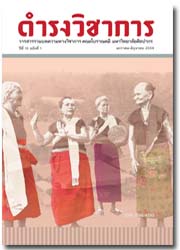Archaeology and Ethnic Group in the Area of Nyah-Kur Villages in Thepsathit District, Chaiyaphum Province
Keywords:
Nyah-Kur people, Chaiyaphum, Trade route, Khmer Kingdom, DvaravatiAbstract
This article is part of the Archaeological Survey of Ancient Trade Routes on the Rim of the Khorat Plateau,Thepsathit District, Chaiyaphum Province Project. The main aim of this project is to study the history of the Nyah-Kur people, speakers of the Old-Mon language which has linguistic similarities to the Dvaravati inscription. The disciplines of ethnoarchaeology and ethonohistory were utilised within this research, which concluded that the initial habitation of the Thepsathit district was from the 12th century CE onwards. Archaeological excavations provided evidence for the categorisation of two distinct time periods, the first being the period between the 12th to 14th centuries CE, and the second within the reign of King Rama V of the Ratanakosin period. The majority of archaeological sites found which were dated to the first period were located near the Chong Chid mountain pass, a passage between the Korat Plateau and the Central Plain of Thailand. Fragments of Khmer and Southern Song ceramic wares were recovered from these survey sites, indicating the expansion of the political influence and trade networks of the Khmer Kingdom within this period. The archaeological sites pertaining to the second period were located within the village of the Nyah-kur people which they inhabited during the reign of King Rama V. This area was identified through research concerning the oral history of the area, the presence of Qing ceramics and coins minted during the reign of King Rama V.
The existing narrative concerning the history of the region was that the invasion of the Khmer Kingdom into the Dvaravati State led to the indigenous Dvaravati people fleeing into the surrounding mountainous areas, which turned them into the Nyah-Kur people. However, the results of the archaeological survey challenge the existing narrative, as no Dvaravati assemblages were recorded. Instead Khmer type assemblages were recovered. This new information has informed new theories concerning the expansion of trade around the 12th century, suggesting that a local indigenous group of possibly but inconclusively the Nyah-Kur settled within the village for the purpose of controlling and benefitting from the trade networks within the mountain pass region. Consequently they became directly involved within the extensive Khmer Kingdom trade network with the ancient communities, trading goods both to the east, especially the Bamnet Narong district and to the west, especially the Lam Sonthi district.
References
ธิดา สาระยา, 2538. (ศรี) ทวารวดีประวัติศาสตร์ยุคต้นของสยามประเทศ. กรุงเทพฯ: เมืองโบราณ.
พิพัฒน์ กระแจะจันทร์, 2558. รายงานฉบับสมบูรณ์โครงการสํารวจหลักฐานทางโบราณคดีและเส้นทางการค้าโบราณในขอบที่ราบสูงโคราชในเขตอําเภอเทพสถิต จังหวัดชัยภูมิ. กรุงเทพฯ: ทุนสนับสนุนการวิจัยมหาวิทยาลัยธรรมศาสตร์.
สุริยวุฒิ สุขสวัสดิ์, 2537. ศิลปะร่วมแบบเขมรในประเทศไทย : ภูมิหลังทางปัญญา-รูปแบบทางศิลปกรรม. กรุงเทพฯ: มติชน.
อําพัน กิจงาม และคณะ, 2550. รายงานการสํารวจแหล่งโบราณคดีสมัยหินใหม่ในประเทศไทย เล่ม 4. กรุงเทพฯ: โครงการสํารวจแหล่งโบราณคดีสมัยก่อนประวัติศาสตร์สมัยหินใหม่ในประเทศไทย กลุ่มวิชาการโบราณคดี สํานักโบราณคดี กรมศิลปากร กระทรวงวัฒนธรรม.
เอนก สีหามาตย์ และคณะ, 2530. รายงานการขุดค้นทางด้านโบราณคดีปรางค์นางผมหอม. กรุงเทพฯ: โครงการบูรณะโบราณสถานลพบุรี กรมศิลปากร.
David N. & Kramer C., 2001. Ethnoarchaeology in Action. UK: Cambridge.
Diffloth G., 1984. The Dvaravati Old Mon Language and Nyah Kur (Monic language studies), vol. 1. Bangkok: Chulalongkorn University Print. House.
Krech S., 1991. “The State of Ethnohistory.” Annual Review of Anthropology 20: 345-375.
Seidenfaden E., 1918. “Some notes about the Chaubun.” Journal of the Siam Society XII (Part 3).
Seidenfaden E., 1919. “Further Notes about the Chaubun, etc.” Journal of the Siam Society 13.3: 47-53.
Sharer R.J. & Ashmore W., 1987. Archaeology: Discovering Our Past. California: Mayfield Publishing Company.
Google Terrain, 2558. Thep Sathit District, Chaiyaphum, Thailand. ค้นเมื่อ 19 มกราคม, 2558, จาก https://www.google.co.uk/maps/place/Thep+Sathit+District,+Chaiyaphum,+Thailand/@15.5996979,101.2251785,10z/data=!3m1!4b1!4m5!3m4!1s0x311f04c105be7abf:0x30469cfc8de6260!8m2!3d15.7125734!4d101.47935!5m1!1e4
นางต่ำ วัดตะขบ, 2558. อายุ 89 ปี, บ้านเลขที่ 26 บ้านวังอ้ายโพธิ์ ต.บ้านไร่ อ.เทพสถิต จ.ชัยภูมิ. สัมภาษณ์, 24 มกราคม.
นายเติม โย้จัตุรัส, 2556. อายุ 73 ปี, บ้านเลขที่ 128 ม.1 บ้านไร่ ต.บ้านไร่ อ.เทพสถิต จ.ชัยภูมิ. สัมภาษณ์, 11 พฤศจิกายน.
นายบุญช่วย ชํานาญดี, 2556. ไม่ทราบอายุน่าจะประมาณ 70 ปี, อดีตกํานันบ้านหนองผักบุ้ง อ.ลําสนธิ จ.ลพบุรี. สัมภาษณ์, 18 พฤศจิกายน.
นายประยูร มองทองหลาง, 2556. อายุ 42 ปี, ม.1 บ้านไร่ ต.บ้านไร่ อ.เทพสถิต จ.ชัยภูมิ. สัมภาษณ์, 5 ตุลาคม.
นายเปลี่ยน เย็นจัตุรัส, 2556. อายุ 64 ปี, บ้านเลขที่ 653 ม.1 บ้านไร่ ต.บ้านไร่ อ.เทพสถิต จ.ชัยภูมิ. สัมภาษณ์, 5 ตุลาคม.
นายพนม จิตร์จําานงค์, 2556. อายุ 42 ปี, ม.1 บ้านไร่ ต.บ้านไร่ อ.เทพสถิต จ.ชัยภูมิ. สัมภาษณ์, 5 ตุลาคม.
นายยัง ยี่จัตุรัส, 2556. อายุ 65 ปี, บ้านเลขที่ 53 ม.1 บ้านไร่ ต.บ้านไร่ อ.เทพสถิต จ.ชัยภูมิ. สัมภาษณ์, 4 ตุลาคม.
นางลึ้ม โคกสันเทียะ, 2557. อายุ 80 ปี, บ้านเลขที่ 51 บ้านวังอ้ายคง ต.บ้านไร่ อ.เทพสถิต จ.ชัยภูมิ. สัมภาษณ์, 16 สิงหาคม.
นายสวิทย์ วงษ์ศรี, 2556. อายุ 52 ปี, บ้านเลขที่ 98 ม.1 บ้านไร่ ต.บ้านไร่ อ.เทพสถิต จ.ชัยภูมิ, สัมภาษณ์, 5 ตุลาคม.
นายสุกิจ เชิดชูณรงค์, 2558. อายุ 63 ปี, บ้านเลขที่ 188/2 ม.2 บ้านชวน ต.บ้านชวน อ.บําเหน็จณรงค์ จ.ชัยภูมิ. สัมภาษณ์, 15 พฤศจิกายน.
นายอ๊าด ยุมจัตุรัส, 2556, 2557. อายุ 73 ปี, บ้านเลขที่ 147 บ้านวังอ้ายโพธิ์ ต.บ้านไร่ อ.เทพสถิต จ.ชัยภูมิ. สัมภาษณ์, 17 สิงหาคม.
นางอิ้ง ชัยขุนทด, 2558. อายุ 56 ปี, บ้านเลขที่ 119 ม.6 บ้านวังอ้ายคง ต.บ้านไร่ อ.เทพสถิต จ.ชัยภูมิ. สัมภาษณ์, 9 มกราคม.
Downloads
Published
Issue
Section
License
บทความนี้เป็นผลงานของข้าพเจ้าแต่เพียงผู้เดียว และ/หรือเป็นผลงานของข้าพเจ้าและผู้ร่วมงาน ตามชื่อที่ระบุในบทความจริง และเป็นผลงานที่มิได้ถูกนำเสนอหรือตีพิมพ์ที่ใดมาก่อน





